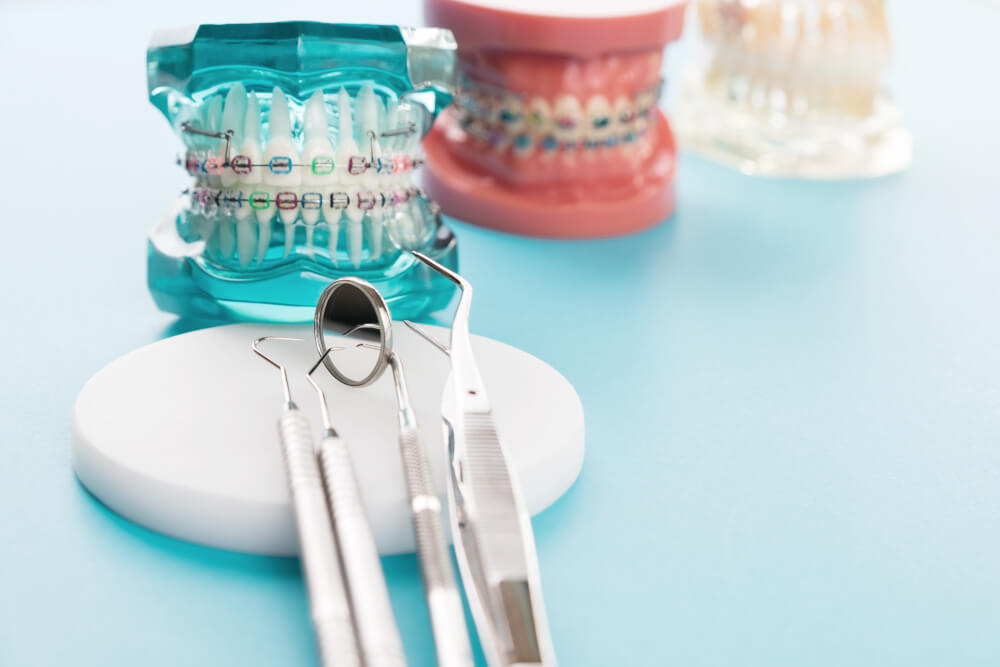Orthodontics involves the alignment of improperly positioned teeth and jaws to improve both function and visual appearance of the mouth and jaw area. Corrections may be applied to improve crooked or crowded teeth, improper bites such as an underbite or severe overbite, or gaps between teeth. Crooked or crowded teeth, left untreated over long period of time, can lead to tooth decay and periodontal disease as proper cleaning between teeth is made difficult due to overlaps. An improper bite creates difficulty in chewing that can lead to tension headaches and TMJ. Proper orthodontics treatment can not only eliminate these risk factors, but also improve the visual appearance of your smile.

What are the different types of orthodontic treatment?
There are a large variety of orthodontic treatment available for different needs and age groups. Some of these include different types of braces, fixed and removeable space maintainers, lip and cheek bumpers, headgear, retainers, and aligners. Three of the most popular are discussed in more detail below.
Metal Braces
Traditional metal braces are one of the most commonly used treatments in modern orthodontics. Frequently used to treat malocclusion in children or adolescents who have all of their adult teeth in place, they are made of metal brackets that attach to the front of the teeth and wires that hold the brackets together. Rubber bands or metal ties may also be used to create additional pressure and in some cases, headgear may be prescribed for nighttime use.
While they are not exactly the most inconspicuous option, metal braces have come a long way in recent years with brackets becoming smaller and providing children and teens with color band options to express their creativity. They are also the most economical option for patients requiring treatment for malocclusion.
Treatment time may vary from several months up to a couple of years depending on the severity of the malocclusion. The braces work gradually by slowly straightening and aligning the teeth to regain a proper bite and brighter smile during the course of treatment.
Contact our family dental clinic for an orthodontics consultation and begin your journey to a brighter smile today!
Clear Braces
Invisible braces, often made from ceramic, use clear or tooth-colored brackets and wires while working similarly to traditional metal braces. They may also be referred to as clear braces or ceramic braces. As the name suggests, these are far less visible than metal braces and therefore more popular with older teens and adults.
Aside from appearance, there are several other advantages that invisible braces have over metal braces.
They are often more comfortable than metal braces as the ceramic material causes less friction against the inside of the mouth than metal. Also, the adhesives used to attach ceramic braces are more gentle and less damaging to the teeth.
There are also some disadvantages to consider. Ceramic braces are created with larger brackets than the metal variety, making maintenance of proper oral hygiene more difficult. They are also more costly than metal braces. Additionally, teeth generally move more slowly, increasing treatment time, and while ceramic braces are extremely durable, they are less so than metal braces and therefore more prone to breakage which may lead to additional costs.
Clear aligners have made an innovative contribution to modern orthodontics, becoming a popular alternative to braces. While invisible braces may be less conspicuous than traditional metal braces, it is safe to say that clear aligners are the truly “invisible” option. This treatment method employs a series of clear aligners that are custom fabricated to adjust teeth incrementally without the use of brackets and wires.
Aside from the obvious visual advantage, clear aligners can be removed for eating and cleaning, eliminating the dietary restrictions present for braces and making oral hygiene maintenance much easier. Without any wires or brackets, they are also more comfortable than braces, and prices are generally comparable to braceswith similar treatment periods.
However, clear aligners are not recommended for severe or complex alignment issues and require diligence in remembering to keep the aligner on for a minimum of 22 hours daily and are therefore not recommended for children.
Our dental clinic partners with Invisalign and ClearCorrect to provide the best clear aligner service the industry has to offer.
Who should see orthodontic care specialists?
Orthodontics is recommended for those with any type of malocclusion issues. Malocclusion refers to an imperfect positioning of the teeth when the jaws are closed and may include patients who have a severe overbite (also known as buck teeth), underbite, crossbite, open bite, crowded teeth, gaps or spaces between teeth, and crooked teeth. These conditions may simply be aesthetic issues, but can also cause difficulties with chewing, speech, and oral hygiene maintenance. In more severe cases of malocclusion, patients often report tension headaches or TMJ.
How do braces or Clear aligners work?
Braces and aligners both work by strategically applying pressure to the teeth to gradually move them into correct positioning in order to improve the function and appearance of the teeth and jaws. Braces use a single set of brackets and wires that are regularly adjusted during regular orthodontics appointments while a series of aligners are fabricated to incrementally adjust the teeth.
Our dental clinic provides in-house services for both braces and clear aligners for the convenience of our patients, partnering with Invisalign and ClearCorrect for fabrication of the highest quality aligners in the industry!